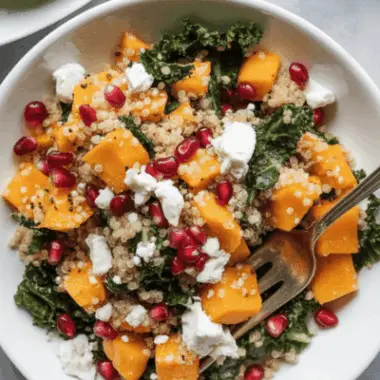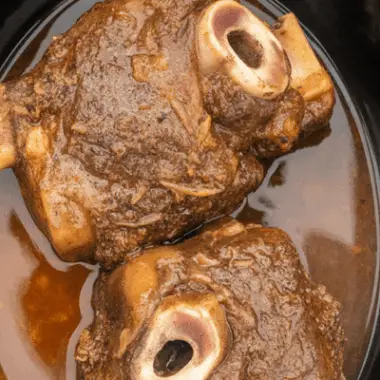Once I learned to cook eggplant this way, I never looked back. It’s tender, caramelized, and on my table at least once a week in summer. This simple sautéed eggplant recipe comes together in about 20 minutes and goes with everything.
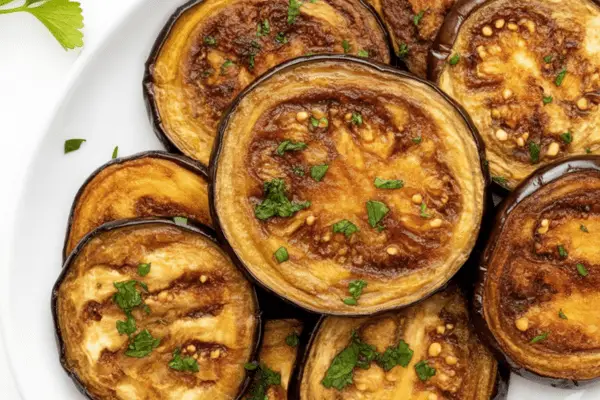
This Sauteed Eggplant Is My All-Time Favorite Eggplant Recipe
I have to admit, I didn’t always love eggplant. For years, it was one of those ingredients I’d buy with good intentions and then forget in the crisper drawer. But one muggy summer day when I absolutely refused to turn on the oven, I had to think on my feet. I usually roast eggplant or air-fry it, but that day I tried cooking it on the stovetop in thick slices with just oil and seasoning.
I honestly didn’t expect much, but it turned out beautifully caramelized and so soft it almost melted on my fork. Now I make it constantly, especially when eggplants are in season at the farmers’ market.
Here’s why I’m obsessed with this method:
- Sweet and tender with golden, caramelized edges – The heat of the pan transforms eggplant’s mild flavor into something almost nutty and deeply sweet. I think the stovetop version even caramelizes better than roasting sometimes.
- Only 5 basic ingredients – Nothing fancy here. Just eggplant, oil, salt, pepper, and garlic powder. This is my weeknight hero recipe that doesn’t need special shopping trips.
- Quick and easy – No need to dice into tiny pieces. I slice it into rounds, which saves so much prep time. The whole thing’s done in about 20 minutes.
- Versatile, healthy side – Naturally gluten-free, light but filling, and it goes with nearly any main. I’ve served it with grilled chicken, salmon, even tucked it into pita with hummus.
That first accidental batch turned this into a staple in my kitchen. I hope it becomes one in yours too.
Ingredients & Substitutions
Here’s what you’ll need and some personal notes on each:
- Eggplant – I usually buy the big globe eggplants because that’s what’s always in my local store. But I’ve used slender Japanese or Chinese eggplants and they work great too. The key is picking one that’s firm with shiny, unblemished skin. I prefer small or medium-sized ones since they’re less bitter and don’t need pre-salting.
- Garlic Powder – I love fresh garlic, but it tends to burn in the hot pan. Garlic powder is my reliable shortcut. If you want fresh, add it right at the end so it doesn’t scorch.
- Olive Oil – I’m a bit of an olive oil snob and always use extra virgin. It adds a ton of flavor. But plain olive oil or avocado oil work just fine.
- Sea Salt & Black Pepper – I like to add a little pinch of crushed red pepper if I want a kick. Sometimes I throw in dried oregano or Italian seasoning if I’m serving it alongside pasta.
This is the kind of recipe you can tweak to fit your pantry. The eggplant really is the star, so don’t overthink it.
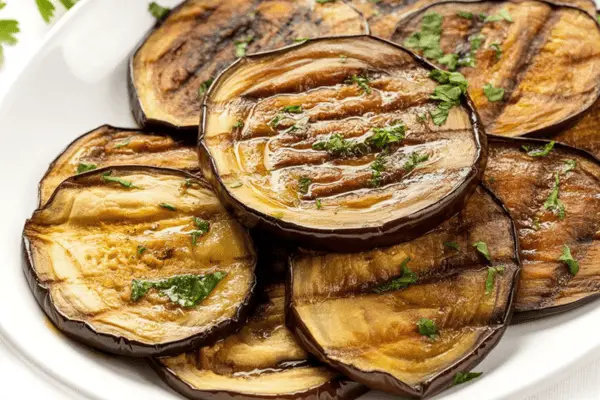
Ways To Cut Eggplant
I’ve played around with all sorts of cuts over the years. Here are my go-to methods:
- Slices (my favorite for this recipe) – Just cut crosswise into 1/4-inch circles. I love the way they brown and soften while keeping their shape. I usually start slicing from the non-stem end, holding the leafy part as a little handle.
- Strips – Good for stir-fries. Slice into rounds first, then stack and cut into long strips.
- Cubes – Best for stews or curries where you want the pieces to hold up without turning to mush.
For sautéing, I really recommend slices. They brown beautifully, and you don’t need to fuss with constant stirring. They’re also the most forgiving—if they’re a little uneven, they’ll still cook well.
How To Cook Eggplant
Here’s how I make it, step by step:
- Slice and season – Cut your eggplant into 1/4-inch rounds. I sprinkle them with salt, black pepper, and garlic powder right on the cutting board.
- Saute until tender – Heat a bit of olive oil in a big nonstick or heavy skillet over medium-low to medium. Lay the slices in a single layer. I usually have to do this in batches, so I keep a plate handy for the finished ones. Let them cook undisturbed so they get that deep golden color before flipping.
- Repeat in batches – Add a little more oil between batches if needed. Eggplant soaks it up like a sponge, so I add gradually to avoid it turning greasy.
- Optional finish – Sometimes I squeeze fresh lemon juice over the cooked slices or toss them with chopped parsley. They’re fantastic served just like that or with a little marinara on the side for dipping.
This is a relaxed kind of cooking—no rushing, just letting the eggplant do its thing in the pan.
My Recipe Tips
Over the years, I’ve picked up a few tricks that make this method foolproof:
- No need to pre-salt smaller eggplants – Modern varieties aren’t that bitter. But if you grab a big one, I do salt it for about 30 minutes, then rinse and pat dry. It makes a difference in taste.
- Leave the skin on – It’s full of nutrients and helps the slices hold together. Even if you don’t eat it, it keeps everything from falling apart in the pan.
- Thin slices are best – About 1/4 inch thick is my sweet spot. Thicker slices take forever to soften and can burn on the outside before they’re cooked through.
- Use a heavy pan – I love my big nonstick skillet because it’s easier to clean, but a heavy-bottomed stainless or cast iron pan browns the best. Just watch the heat so nothing sticks.
- Don’t fuss with it – The best browning happens when you leave the slices alone. I only flip them once.
- Add oil in batches – Eggplant will drink up oil like crazy. I used to pour it all in at once and wonder why it was swimming. Now I add a bit with each batch so it’s nicely coated but not greasy.
- Check for doneness by pressing gently – I just press with my spatula. If it feels soft and has some give, it’s ready.
- Watch the heat – Medium or medium-low is my go-to. If the outsides are browning too fast but the inside’s still firm, lower the heat and give it more time.
- Want to speed it up? – Use two skillets side by side. I do this when I’m cooking for friends and don’t want to stand at the stove all evening. More pans to wash, but worth it.
Flavor Variations
I love this base recipe because it’s a blank canvas. Some ways I change it up:
- Add a pinch of smoked paprika for a deeper, savory flavor.
- Finish with lemon zest and fresh herbs for brightness.
- Toss cooked slices in balsamic glaze.
- Sprinkle grated parmesan while it’s still hot so it melts a bit.
- Add red pepper flakes for heat.
It’s one of those recipes that adapts to whatever mood I’m in or whatever I have in the fridge.
Serving Ideas
This sautéed eggplant is a total workhorse. Here’s how I serve it most often:
- As a simple side for grilled chicken, lamb chops, or baked fish.
- Layered on toasted sourdough with ricotta or hummus for an easy lunch.
- Stuffed into pita with chopped tomatoes, cucumber, and tzatziki.
- Mixed with pasta, olive oil, and fresh basil.
- Even cold, chopped into salads with feta and olives.
I’ve even served it as part of a mezze spread with pita, dips, and olives for friends. It disappears fast.
Storage
This dish keeps surprisingly well. I often make extra:
- Store in an airtight container in the fridge for up to 4 days.
- To reheat, I either microwave it quickly or toss it back in a pan for a minute or two.
- It doesn’t freeze well—the texture gets mushy—but honestly it never lasts that long in my house.
I love having leftovers ready to tuck into wraps or grain bowls for lunch.
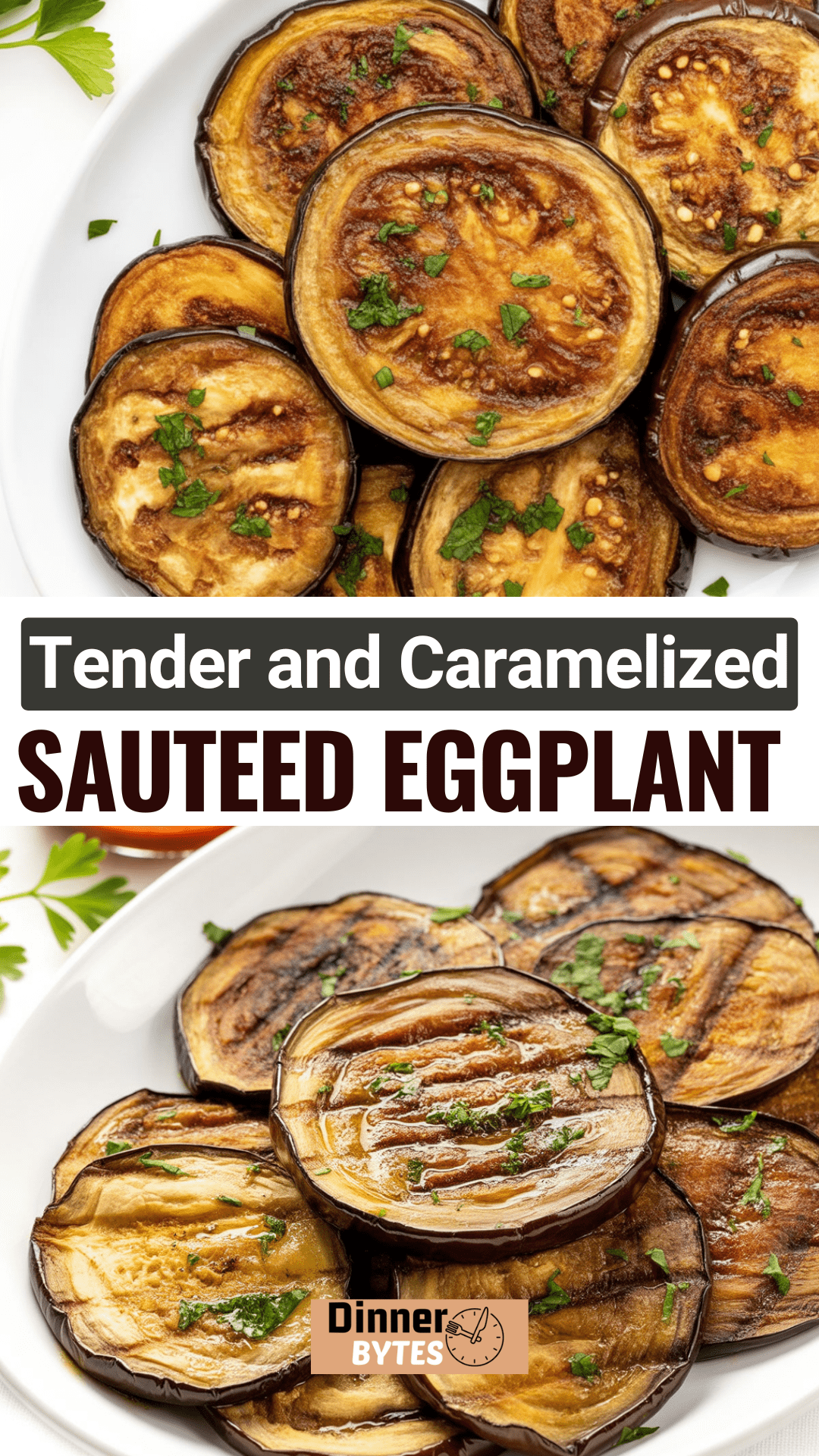
FAQs
Do I have to salt eggplant first?
Not always. Smaller, younger eggplants are usually fine without it. I only salt larger ones that might be a little bitter.
Can I use other types of eggplant?
Absolutely. I’ve used Japanese and Chinese varieties, even small white eggplants from my neighbor’s garden. Just adjust cooking time if they’re smaller.
What oil should I use?
I love extra virgin olive oil for the flavor, but use whatever you have. Avocado oil is another favorite.
Can I make it ahead?
Yes! I often cook it in the morning if it’s too hot to stand over the stove at dinnertime. It reheats beautifully.
Sauteed Eggplant

Once I learned to cook eggplant this way, I never looked back. It’s tender, caramelized, and on my table at least once a week in summer.
Ingredients
- 1 medium eggplant (~1 lb, sliced into 1/4-inch-thick rounds)
- 1/2 tsp garlic powder
- 1/4 tsp sea salt
- 1/4 tsp black pepper
- 1/4 cup olive oil (more as needed)
Instructions
- Start by slicing the eggplant crosswise into 1/4 inch thick rounds. Leave the leafy end on while slicing so you have a better grip, then trim it off at the end. If the slices seem damp, give them a quick pat with a paper towel.
- Sprinkle both sides of each slice with garlic powder, sea salt, and black pepper.
- In a large 12-inch nonstick skillet, heat 2 tablespoons of olive oil over medium-low to medium heat. Add the eggplant slices in a single layer, working in batches.
- Cook each slice for 3 to 6 minutes per side until soft, nicely browned, and caramelized.
- Continue with the remaining slices, adding 1 to 2 tablespoons of oil as needed for each new batch.
Notes
- Serving size is about 4 to 5 slices, or one-fourth of the full recipe.
- For best browning and caramelization, avoid crowding the pan and give the slices enough time to sear. Patting the eggplant dry before cooking also helps reduce sogginess.
Nutrition Information
Yield
4Serving Size
1Amount Per Serving Calories 171Total Fat 14gSaturated Fat 2gTrans Fat 0gUnsaturated Fat 11gCholesterol 0mgSodium 147mgCarbohydrates 13gFiber 4gSugar 5gProtein 1g
dinnerbytes.com, occasionally offers nutritional information for recipes contained on this site. This information is provided as a courtesy and is an estimate only. This information comes from online calculators. Although dinnerbytes.com attempts to provide accurate nutritional information, these figures are only estimates.

